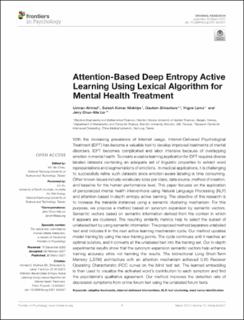| dc.contributor.author | Ahmed, Usman | |
| dc.contributor.author | Mukhiya, Suresh Kumar | |
| dc.contributor.author | Srivastava, Gautam | |
| dc.contributor.author | Lamo, Yngve | |
| dc.contributor.author | Lin, Jerry Chun-Wei | |
| dc.date.accessioned | 2022-03-09T13:16:18Z | |
| dc.date.available | 2022-03-09T13:16:18Z | |
| dc.date.created | 2021-07-08T09:47:09Z | |
| dc.date.issued | 2021 | |
| dc.identifier.citation | Ahmed, U., Mukhiya, S. K., Srivastava, G., Lamo, Y., & Lin, J. C.-W. (2021). Attention-Based Deep Entropy Active Learning Using Lexical Algorithm for Mental Health Treatment. Frontiers in Psychology, 12:642347. | en_US |
| dc.identifier.issn | 1664-1078 | |
| dc.identifier.uri | https://hdl.handle.net/11250/2984058 | |
| dc.description.abstract | With the increasing prevalence of Internet usage, Internet-Delivered Psychological Treatment (IDPT) has become a valuable tool to develop improved treatments of mental disorders. IDPT becomes complicated and labor intensive because of overlapping emotion in mental health. To create a usable learning application for IDPT requires diverse labeled datasets containing an adequate set of linguistic properties to extract word representations and segmentations of emotions. In medical applications, it is challenging to successfully refine such datasets since emotion-aware labeling is time consuming. Other known issues include vocabulary sizes per class, data source, method of creation, and baseline for the human performance level. This paper focuses on the application of personalized mental health interventions using Natural Language Processing (NLP) and attention-based in-depth entropy active learning. The objective of this research is to increase the trainable instances using a semantic clustering mechanism. For this purpose, we propose a method based on synonym expansion by semantic vectors. Semantic vectors based on semantic information derived from the context in which it appears are clustered. The resulting similarity metrics help to select the subset of unlabeled text by using semantic information. The proposed method separates unlabeled text and includes it in the next active learning mechanism cycle. Our method updates model training by using the new training points. The cycle continues until it reaches an optimal solution, and it converts all the unlabeled text into the training set. Our in-depth experimental results show that the synonym expansion semantic vectors help enhance training accuracy while not harming the results. The bidirectional Long Short-Term Memory (LSTM) architecture with an attention mechanism achieved 0.85 Receiver Operating Characteristic (ROC curve) on the blind test set. The learned embedding is then used to visualize the activated word's contribution to each symptom and find the psychiatrist's qualitative agreement. Our method improves the detection rate of depression symptoms from online forum text using the unlabeled forum texts. | en_US |
| dc.language.iso | eng | en_US |
| dc.publisher | Frontiers Media | en_US |
| dc.rights | Navngivelse 4.0 Internasjonal | * |
| dc.rights.uri | http://creativecommons.org/licenses/by/4.0/deed.no | * |
| dc.title | Attention-Based Deep Entropy Active Learning Using Lexical Algorithm for Mental Health Treatment | en_US |
| dc.type | Peer reviewed | en_US |
| dc.type | Journal article | en_US |
| dc.description.version | publishedVersion | en_US |
| dc.rights.holder | © 2021 Ahmed, Mukhiya, Srivastava, Lamo and Lin. | en_US |
| dc.source.volume | 12 | en_US |
| dc.source.journal | Frontiers in Psychology | en_US |
| dc.identifier.doi | 10.3389/fpsyg.2021.642347 | |
| dc.identifier.cristin | 1920917 | |
| dc.relation.project | Norges forskningsråd: 259293 | en_US |
| dc.source.articlenumber | 642347 | en_US |
| cristin.ispublished | true | |
| cristin.fulltext | original | |
| cristin.qualitycode | 1 | |

